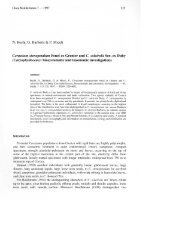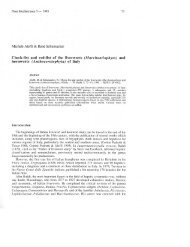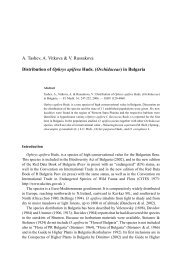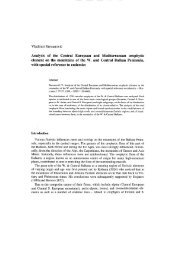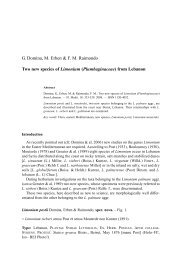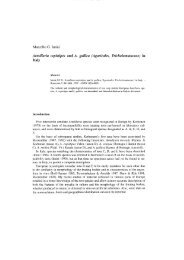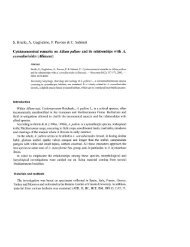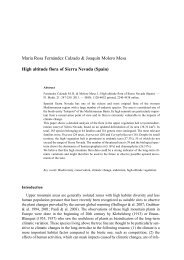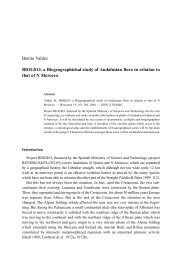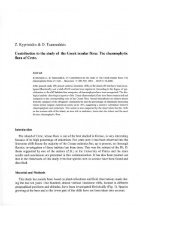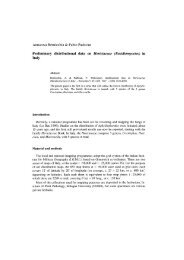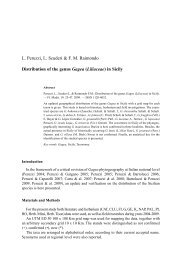Christoph Oberprieler The Systematics of Anthemis L. - Herbmedit.org
Christoph Oberprieler The Systematics of Anthemis L. - Herbmedit.org
Christoph Oberprieler The Systematics of Anthemis L. - Herbmedit.org
You also want an ePaper? Increase the reach of your titles
YUMPU automatically turns print PDFs into web optimized ePapers that Google loves.
Bocconea 9 - 1998 31<br />
<strong>The</strong> styles are also very uniform throughout the genus. <strong>The</strong> base <strong>of</strong> the style becomes<br />
usually swollen and hardened due to enlarged and sclerified cells. Two vascular bundles<br />
run through the cylindrical and glabrous style shaft and end in the stigmatic branches,<br />
which are truncate-penicillate, bearing two separate lines <strong>of</strong> stigmatic papillae on the inside<br />
and obtuse sweeping hairs at their apex. Usually the stigmatic branches contain elongate<br />
resin ducts with a brown or orange content.<br />
Achenes<br />
Like the vast majority <strong>of</strong> Compositae, <strong>Anthemis</strong> has dry, monosperrnous fruits developed<br />
from a bicarpellate coenocarpic inferior ovary, with the seed testa adhering to but not<br />
coalescent with the pericarp. Although the ovary <strong>of</strong> Compositae is inferior, the fruit wall is<br />
generally terrned pericarp, and its structures usually been described in the terrns <strong>of</strong> epi-,<br />
meso- and endocarp, by analogy to the fruit wall in a superior ovary. Following Wagenitz<br />
(1976) and Roth (1977), the terrn "achene" as defined by Candolle (1813) is used in the<br />
present work for this type <strong>of</strong> fruits. <strong>The</strong> term "cypsela" was introduced by Mirbel (1815)<br />
and is frequently used in Anglo-Saxon and Nordic synantherologicalliterature (e.g. Humphries<br />
1979, Kiillersj6 1991, Anderberg 1991a, b, c, Bremer & Humphries 1993, Bremer<br />
1994). However, exceptions are found (e.g. Hansen 1991), and in Anglo-American literature<br />
the term "achene" still prevails (e.g. Stuessy 1968, Funk 1982, Jansen 1985, Panero<br />
1992).<br />
Dating back to the thorough studies <strong>of</strong> Briquet (1916), the paramount importance <strong>of</strong><br />
achene morphology and anatomy for the taxonomy <strong>of</strong> Anthemideae and for the delirnitation<br />
<strong>of</strong> genera in this tribe is well known. In <strong>Anthemis</strong> the achenes provide some very<br />
important diagnostic features for the subdivision <strong>of</strong> the genus and the circumscription <strong>of</strong><br />
species groups.<br />
Achenes <strong>of</strong> ray florets were found to be rather similar in most studied representatives <strong>of</strong><br />
<strong>Anthemis</strong> subg. <strong>Anthemis</strong>. <strong>The</strong>y are usually subcylindrical or fusiforrn in shape and slightly<br />
bent inward. Being tightly confined to the trigonal space between the achenes <strong>of</strong> peripheral<br />
disc florets and their pales and the flat inner surface <strong>of</strong> the inner involucral bracts, they are<br />
roundish to triangular in cross section, with a flattish abaxial and a rounded or edged adaxial<br />
face. <strong>The</strong> achenes <strong>of</strong> ray florets usually have (8-)9( -lO) ribs which are rather indistinct<br />
on the adaxial but more prorninent and in some species even tuberculate on the<br />
abaxial face. Like the achenes <strong>of</strong> disc florets, they are usually beset with mucilage cells on<br />
their ribs and by glands in the intercostal furrows. <strong>The</strong> apical plate is usually bordered with<br />
a ridge that in some species is adaxially protracted into a membranous auricle up to 0.3<br />
mm long. <strong>The</strong> achenes <strong>of</strong> ray florets in A. austriaca (A. subg. Cota), unlike those in<br />
A. subg. <strong>Anthemis</strong>, strongly resemble achenes <strong>of</strong> disc florets in being conspicuously flattened<br />
dorso-ventrally.<br />
<strong>The</strong> achenes <strong>of</strong> disc florets provide a greater number <strong>of</strong> characters <strong>of</strong> use for species<br />
delirnitation and supraspecific classification than the achenes <strong>of</strong> ray florets. While essentially<br />
homomorphic, the achenes'<strong>of</strong> disc florets tend towards heteromorphy in most <strong>of</strong> the<br />
species due to overall structural reduction from the larger peripheral to the smaller centraI<br />
achenes. In some species, the differences between achenes <strong>of</strong> marginaI and centraI disc<br />
florets are particularly well marked: In <strong>Anthemis</strong> mauritiana and A. arvensis the achenes<br />
<strong>of</strong> peripheral disc florets are extremely stout and subcylindrical or obconical, while the<br />
centraI achenes are much more slender and obconical-obovoidal. In most N African An-



